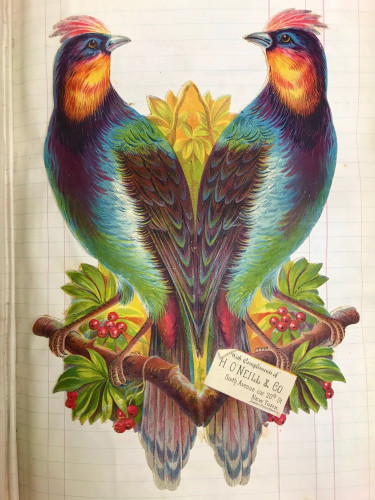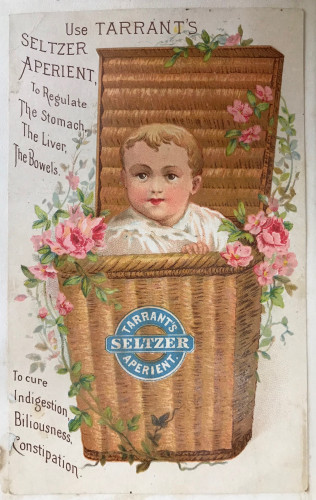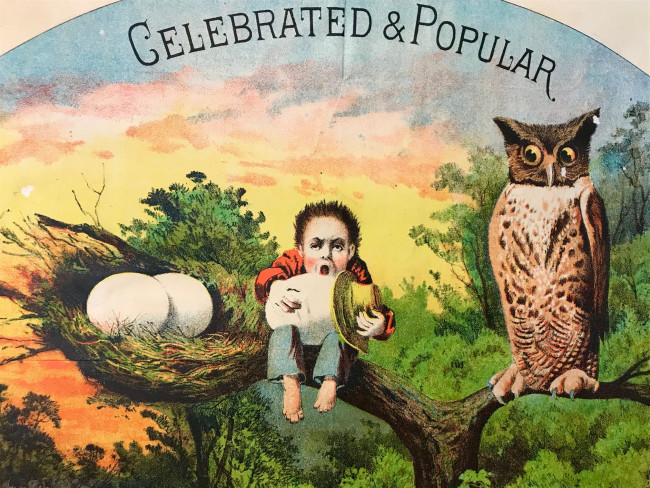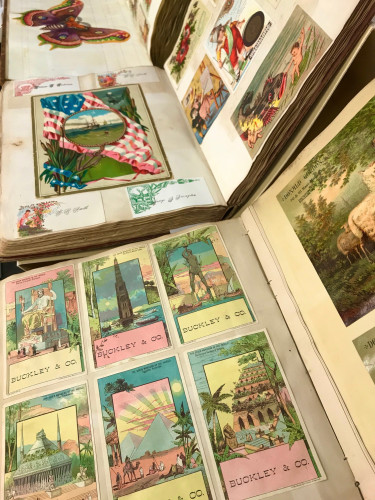
As we move solidly into the dread drears of Rochester winter, I expect we could all use a bit of a reminder that there are other colors in the world besides gray, white, and white-gray. We are all, I think, struggling a little bit- to find the energy, to remember the warmth of summer, to string five words coherently together without coffee. For this month as a gift from the land of history, please have this appropriately image-heavy post featuring a delightfully jarring juxtaposition of expectations: Behold. The Victorians’ love of technicolor.
[Two vibrant birds on an oversized trade card from H. O’Neill & Co., NYC, c. 1880.]
Lithography is a printing technique which uses a flat stone or metal plate prepared with grease-based designs and etched with acids to create a negative plate of a picture. The reversed plate can be speedily prepared and inked with oil-based pigments to produce highly-detailed images stamped with a dizzying array of colors. It experienced a rapid ascent to popularity in the 1870s, for obvious reasons- its blinding eye-catching splendor and the advent of terrifying, intense chemical dyes made for some almost psychedelic prints. Companies like the Church & Phalen store of Troy, NY (among many, many others) took advantage of the process’s widespread appeal and printed trade cards featuring elaborate artwork on one side, and an advertisement for their products or services on the other. Stationary stores printed greeting cards, religious cards, calling cards, and even gift labels with similar styles, too. Collectors often organized and pasted their gems into scrapbooks featuring hundreds of unique examples, which have retained their impressive color for well over a century. I’m very excited to have recently processed a collection of twelve of these trade card scrapbooks for Special Collections, which you can now come by and see for yourself if you’d like an extra blast of color in your day.

[Trade card with a baby in a floral basket advertising Tarrant’s Seltzer Aperient, 1880s.]
Of course, like our dreams of warmth in winter, sometimes the product and presentation are a bit… misaligned. We can’t be sure if this floral basket baby advertising laxatives, for instance, is meant to be read as tongue-in-cheek, or if, like some modern commercials, someone somewhere just completely missed the mark in an effort to get some attention on their product. There are also cards which can only rightfully be described as racist, which attempt to cash in on popular humor of the era at the expense of people of color, Asian immigrants, and Native Americans. The inclusion of these alongside frilly Valentines and owls advertising clothing shops is another rude juxtaposition- one which is ample ground for examination about what we find funny, the contextual “moment” of humor, the roles and lasting effects of humor and image in history. But for every dark moment of winter, remember: there is a glorious, gaudy morn.

[“Celebrated & Popular” sunrise trade card, 1880s.]
Ah, yes. It’s snowing outside. Come in from the cold wet, and come warm yourself by the acid-bright glow of a garish turn-of-the-century yuletide fireplace. Or perhaps you’d prefer the neons of early Springtime thoughts? Frog gentlemen posing in a garden? Cherubs prodding at a monkfish?

If, however, you’re still feeling just a bit seasick between the rush of the semester, the holidays, family, the worries of the world, and the ever-present capital-W-Weather, don’t worry. While the collectors’ scrapbooks featured in this collection rarely take a demure break on the color schemes, their catch-all assortments of greeting cards of the era also show us that in some respects, the Victorians knew exactly how to express those feelings, too.

[“A Christmas Greeting with Love” featuring a distressed teapot child, 1880s]
Happy Winter, everyone. Stay bright.
Lev Earle – they/them
Special Collections Processing Archivist, RBSCP
The Special Collections Processing Archivist prepares, organizes, and describes new and legacy collections for researcher use, making collection information searchable in the library catalogue. Have a question about something mentioned in this article? Email learle@library.rochester.edu.


